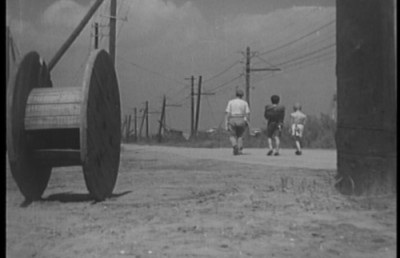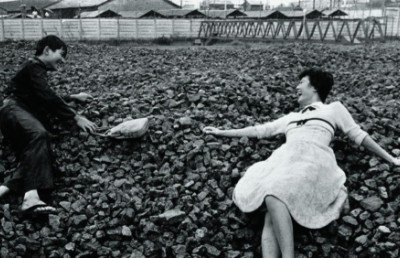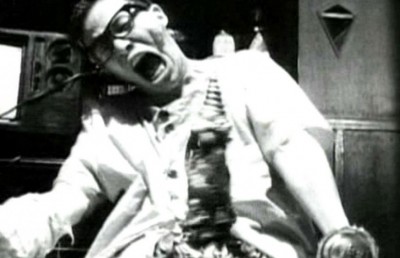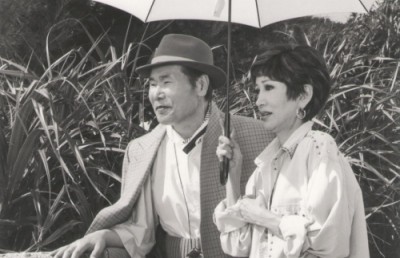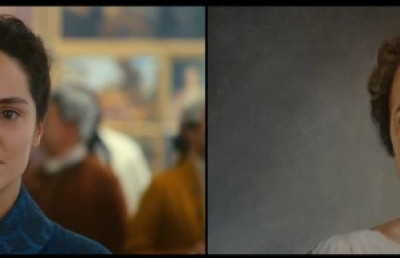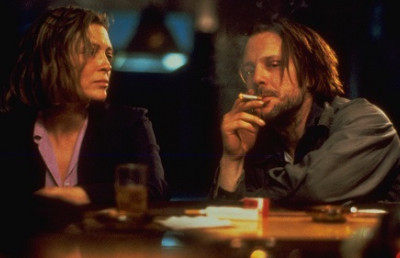Musical Peace-Pact: Sound and Music in Heinosuke Gosho’s The Neighbour’s Wife and Mine (1931)
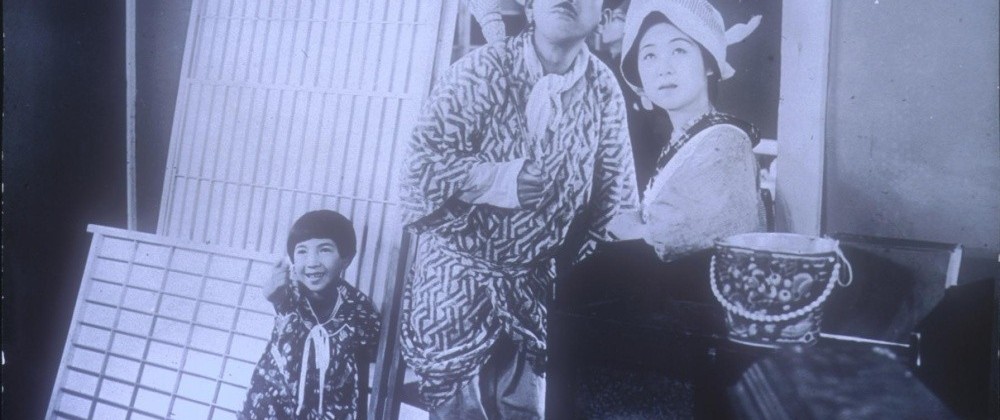
The sound film was not born overnight. The genesis of talkies was the culmination of a long history of trial and error by various technicians and artists, all inspired to bring the “myth of total cinema” one step closer to reality. Therefore, from the first talking pictures, sound has been incorporated to serve a dramatic function and underpin the narrative. Widely considered the first talking picture, The Jazz Singer (1927, Alan Crosland) is structured upon a confrontation between two sets of values represented by characters belonging to different generations, a jazz singer and his traditional cantor father. This generational rift first and foremost surfaces in the form of the division between jazz, at that time the music of the modern present, and traditional and ceremonial Jewish music. Sound, which in The Jazz Singer largely consists of music, is not only the source of dramatic tension, but in its denouement takes on a mediatory role to communicate the reconciliation of the singer with his father and, by extension, a peace treaty between traditional and modern values. Made four years after The Jazz Singer , the first Japanese all-sound film, The Neighbour’s Wife and Mine (1931) uses the songs in its narrative for a similar effect. Directed by Heinosuke Gosho for Shochiku studio, the film is not a musical, but a light comedy. Nevertheless, as in The Jazz Singer , the issue of modernity is central to the plot. In the case of Gosho’s film, modernity comes hand in hand with the concept of Westernization and the encounter with an outsider culture. Gosho made use of American-style songs in conjunction with narrative and mise-en-scène to advocate the embrace of Western culture by Japanese society, albeit with a degree of wariness. Gosho not only celebrated the advent of the sound technology by making full use of it as an integral part of the structure of his film, but also endowed it with the task of representing and negotiating modernity.
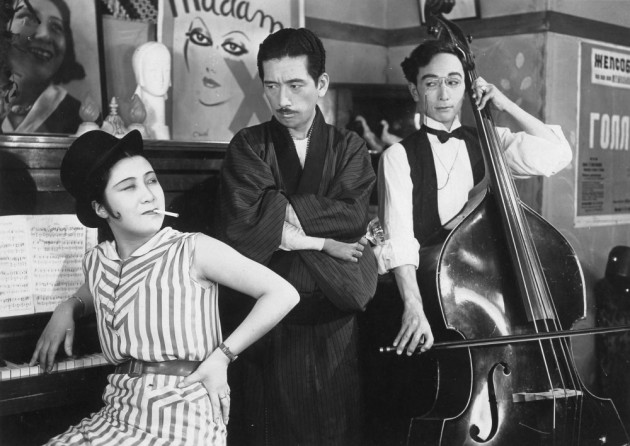
The writer with the modern neighbour’s wife.
The Neighbour’s Wife and Mine is not Japanese cinema’s first experiment in working with sound; however its success, which gave momentum to sound film production in Japan, sets it apart from its predecessors. Donald Richie and Joseph L. Anderson believe that The Neighbour’s Wife and Mine still represents one of the best applications of sound in early Japanese films (73). With regards to Gosho’s careful adoption of sound technology, Kenji Iwamoto considers the film an aesthetic as well as financial success (315). The earlier experiments with sound had employed the sound on disk technique and all met with critical and commercial failure (Anderson and Richie 77). As an alternative, Nihon Toki Company tried dubbing, but once again the results were far from satisfactory (Anderson and Richie 74). For Gosho’s film, Shochiku used the Tsuchihashi sound on film system, a technology named after its inventor, Tsuchihashi Takeo (Iwamoto 319).
In comparison to other countries, the conversion of Japanese cinema to sound arrived late. According to Noel Burch, the reason for this slower pace was in part financial, as the film industry’s small profit margins were not sufficient to purchase the new equipment, and the Japanese movie studios could not rely on bank loans (Burch 42). However, one should not lose sight of the specific conditions of screening in Japan, where benshis were always present to accompany the screening with translations and live commentaries. According to Hiroshi Inagaki, one of the esteemed filmmakers of Japanese classic cinema, spectators learned to accept the benshi ’s commentary as though it was being delivered by characters on the screen (Anderson 292). The resistance shown by these commentators who found themselves on the brink of unemployment should not be discounted as another hindrance to the conversion process. Shochiku released a silent film as late as 1935, and the production of silent films did not end until the government banned their production in 1941 (Anderson 292).
It was not Gosho’s choice to helm the first Japanese “all-talkie” motion picture. Indeed, other directors approached by Shochiku had already turned them down, probably due to their disappointment with earlier sound film experiments (Nolletti 3). But when Gosho was asked, his recent series of flops left him little room to refuse (Nolletti 3). Gosho decided to shoot the film using a multiple camera setup, which helped him avoid the limiting static style of some early American sound films and gave him more freedom in editing. It also allowed him to move his camera, as evidenced by the film’s early panning shot across a field. The music had to be recorded on set, so Gosho recruited a jazz orchestra to accompany the crew, but they had to be occasionally kept outside the camera view and were at some points hidden among bushes and trees (Nolletti 18). Upon its release, the film sparked an enthusiastic response. Kinema Jumpo film critic Tamura Yukihiko praised the film, writing: “It is not only the first talkie produced by [Shochiku] Kamata Studios, it is the first full-fledged talkie to be produced by the Japanese film industry. With this film we can announce to the world that we have talkies in Japan too” (Iwamoto 319).
The Neighbour’s Wife and Mine can be divided into four segments, with the first and last scenes serving as prologue and epilogue to a rather simple main plot: a playwright (Atsushi Watanabe) who has to finish composing his play before the deadline is continually distracted by surrounding noises. With the exception of the music we hear on the opening titles and the writer’s whistling, Gosho does not introduce the music into his film until the third part of the film; yet when integrated in the form of songs, the music conducts the story towards its resolution. Again, Gosho was not the first Japanese director to put a song in his film. An earlier extant use of song could be found in Mizoguchi’s first talking picture, Hometown (1930), released 15 months prior to Gosho’s The Neighbour’s Wife and Mine . Mizoguchi’s film is another attempt to translate the friction between two cultures at the level of the soundtrack. The opening scene of Hometown features a patriotic song with a patriotic content that contrasts with the other music pieces that are included (mostly jazz and opera music), calling into question the glistening façade of Western culture to which the main hero temporarily falls prey. Unlike Gosho’s film, but not dissimilar to The Jazz Singer , Mizoguchi’s film was a hybrid creature that only occasionally used dialogue (Le Fanu 155-6). Aside from this, sound in Mizoguchi’s film seems to have been used mainly as an added attraction in order to boost the box-office gross. The success of Gosho’s film has been also partly ascribed to its natural sounding dialogue. In fact, one criticism that Hometown faced was its stilted dialogue, which was in addition to the technical problems, and rooted in the widespread uncertainty over the kind of language they should use for dialogue. What they were seeking was, according to Mizoguchi: “a new form of language that is neither stage dialogue nor everyday conversation” (Iwamoto 318). Similarly, Japanese filmmakers were not certain enough about the dialects in which the lines had to be delivered. To cope with this problem, Gosho decided to cast actors who had no background in stage performance, so that their acting and mode of speech could carry a matter-of-fact quality (Iwamoto 16).
As a filmmaker, Gosho’s reputation to a large extent rests on his contribution to a genre widely known as shomingeki (“tales of everyday folk”), particularly the type known as shoshimin-eiga , which dealt with the lower middle-class (Richie and Anderson 78). At the narrative level, shoshimin-eiga demonstrated common features in using simple plots and de-emphasizing the narrative in favour of eliciting a sense of everyday reality (Nolletti 13-14). Shoshimin-eiga mostly used a loose narrative, which sometimes took a backseat to the subplots. The Neighbour’s Wife and Mine and Gosho’s next two films were the result of the marriage of this genre with “nonsense comedies” ( nansensu-mono ), a term used to define a group of light comedies made from 1920 onward in which the sequential gags were not intended to make any sense. Anderson and Richie believe this comic shift in shomingeki had been triggered by the conversion to sound (98). According to Nolletti, The Neighbour’s Wife and Mine and Gosho’s two succeeding films have been described as “virtually plotless and feeling more like comic sketches than fully developed stories, these three light comedies, or farces, take a wholly trivial matter […] and use it as a springboard for a succession of gags” (Nolletti 16). In The Neighbour’s Wife and Mine in particular, the absence of a strong narrative thread allows the sound to assume a more dramatic role and mutate into the main force pushing the drama forward. It is worth saying that the integration of the sound also brought a larger number of bourgeois to the movie theaters, who expected to watch more realistic pictures, and, in response to this desire, realism became a major tendency in the 1930s (Burch 145). In view of this trend and affinities shown by Gosho’s film with shomingeki , it is safe to claim The Neighbour’s Wife and Mine as a prototype of this tendency. Instead of telling a story, the film is more intent on documenting everyday life in a modernizing Japan and the ever-increasing influence of Western culture as embodied by jazz music and Western style dress. In keeping with this notion, Gosho used sound and music in a realistic manner that set it apart from a film like A Tipsy Life (1933, Sotoji Kimura), the first Japanese musical, which arrived two years later (Iwamoto 324).
The simplicity of the plot of The Neighbour’s Wife and Mine allows us to draw an analogy between this film and The Jazz Singer in the sense that the creators of both films eschewed a complicated narrative in order to make the audience’s confrontation with the new technology less confounding. This concern, along with financial considerations, led Japanese producers to avoid more ambitious projects for a short while. The story behind the production of one of Gosho’s later films, The Dancing Girl of Izu (1933), confirms this point. In making a screen adaptation of a prestigious literary resource like Kawabata’s story, Gosho was intent to make use of sound technology, however he had no success in persuading Shochiku to invest in this project until he agreed to make the film as a silent (Wada-Marciano 45). 1
No discussion of Neighbour’s Wife and Mine should exclude the role of the studio behind its production. Starting its filmmaking activity in 1920, Shochiku very soon flourished and became one of the major film production studios in Japan. The company’s agenda clearly stated its ambitions to follow Western movies in style, and this trend was accelerated under the supervision of Shiro Kido, the famed studio head of the studio who took over in the wake of the devastating earthquake of 1923. Through manifesting such an interest in imitating Hollywood, Shochiku distinguished itself from more conservative studios such as Nikkatsu. For instance, Shochiku was the first studio that began to cast actresses instead of oyama (female impersonators) in woman’s roles. It also adopted concepts from the “pure film” movement ( Jun eigageki undo ), which was again influenced by Hollywood cinema. As a result, shoshimin-eiga became a Shochiku specialty (Wada-Marciano 23).
One of this genre’s defining features was its relationship with everyday reality. However, unlike the so-called “tendency films” ( keiko-eiga ), a group of films with overt political messages for social change, released in 1929-1930, which encountered censorship problems, the social implications of shoshimin-eiga were confined to documenting the present situation of society without suggesting progressive solutions or pointing to the roots of problems (Wada-Marciano 22). With protagonists who were “autonomous individuals,” shoshimin-eiga , as Mitsuyo Wada-Marciano explains, attempted to express the “unevenness of Japanese modernity” through documenting and contrasting changes in public and private spaces, especially the latter, which “was subordinated to modernity’s reorganization of production” (22).
As a representative Shochiku shoshimin-eiga , The Neighbour’s Wife and Mine sticks close to this model by placing the cultural encounter between traditional Japan and the modern West at its heart, but at the same time obliquely suggesting a way for reconciliation. The proposed solution, aided by the new technology of sound, provides an example of Shochiku’s ongoing assimilation of Hollywood cinema. “Shochiku Kamata style,” the term coined to define the style of films made between 1920-1936 at Shochiku’s Kamata studio, is a good indicator of how Japanese cinema came to terms with techniques imported from Hollywood and absorbed them into the structure of its own products. Kamata style came in to being through deployment of Hollywood stylistic elements in narratives grounded in Japanese urban life. Filmmakers, however, extrapolated this policy of negotiation to Japanese society by showing how Japan, with its specific cultural and historical background, could undergo a transition to modernity (Wada-Marciano 79).
Gosho’s first experiment with sound testifies to his awareness of the capacities of the new technology. He demonstrates a talent for using off-screen sound and turns it into one of the film’s chief stylistic motifs. The use of off-screen sound starts very early in the film, as we hear the writer’s whistling over the image of the painter, which prepares us for the writer’s eventual appearance in the frame. In fact, he whistles a melody from René Clair’s notable early sound film, Sous les toits de Paris (1930) (Iwamoto 320). Gosho repeats this situation throughout the film. He allows sound to precede the corresponding image, and so implicitly privileges the new technology. On some occasions, this strategy generates comic effects, as when the writer, chased by the painter, rushes into a house and we hear the shriek of a woman who later turns out to be the neighbour’s wife of the title (Satoko Date). By associating specific noises with specific objects in the frame, Gosho uses sound effects to create expressive meaning. For example, when the writer’s wife (Kinuyo Tanaka) finds a coin in the ashes, we hear a noise as it drops. While the noises of other visible objects are almost muted, this sound is distinct and audible in order to underscore the financial needs of the family. In another instance, when the writer pokes fun at the painter by handing him a plastic toy, the funny noise we hear over the image of a squeezed toy makes his banter all the more derisive. Off-screen sound is also used to create visual economy, as when the writer’s friends leave his house. The audience hears them saying goodbye, but does not see them depart. 2
Shochiku films were informed by an implicit mission to address the issue of a modernizing Japanese society. The Neighbour’s Wife and Mine fits this description, but what gives further weight to its message and enables Gosho to better communicate his views is the use of songs and their place in the narrative. Two songs are performed during the scene in which the writer visits the neighbour’s house to complain about the loud music. The song titles reveal what they are about; “Speed jidai” and “Speed hoi” both revolve around the idea of speed, a defining feature of modernity and its related technologies. The film stresses the connection between the increased rhythm of life and the imported concept of modernity by using the English word “speed” in the song titles instead of a Japanese translation. At the same time, speed is what the writer needs to make the deadline and support his family. This urge for speed, however, is promoted by a kind of music which originated in the West, but ironically turns into an inspiration for the Japanese writer. It is interesting to observe how the family, which is highly revered in traditional Japanese culture, finds its saviour in the garb of an entertainment rooted in Western culture. In this instance, Gosho’s treatment of Western culture is entirely different from the stance Mizoguchi adopted in his first sound film.
Another aspect of the modern, the figure of the female singer as the embodiment of Westernization, is also foregrounded. In the film’s title she is referred to as “Madamu” (the Japanese title is Madamu To Nyobo ), which is the Japanese form of address to a respectable married woman. The modern girl, or moga (the American equivalent at the time would be flapper) is a recurrent character in Japanese films of the late 1920s and early 1930s. For this frequently used character, who represents the assimilation of Western culture and values, two principal applications can be enumerated. On the one hand, her image was streamlined into the domain of commercialism to showcase the glistening luxury of Western culture, which had its own appeal for the spectators, many of them believed to be women. On the other hand, by detaching this character from the rest of the community, her image was rendered neutral, allowing the films to suggest that Japanese society had control over the imported culture and, by limiting it to a peripheral position in the narrative, deflected its potential threat to traditional values (Wada-Marciano 87). These modern women sometimes assumed the role of a “vamp” who tries to lure the hero away from his fidelity to tradition. This, however, is not true of the main Westernized figure in The Neighbour’s Wife and Mine . Despite her conspicuous attachment to the West, she not only dresses in Western style, but even sprinkles her speech with English words, she has no sexual designs on the married writer, and falls short of being a true “vamp” (Nolletti 19). 3 This different treatment could be partly conditioned by the genre Gosho has chosen to work in, a hybrid of shoshimin-eiga and nansensu-mono , which downplays potential threats to the level of mockery.
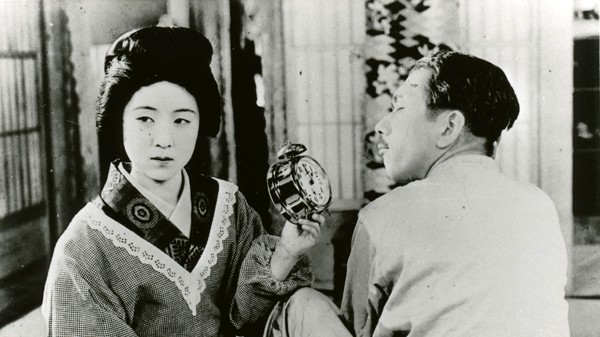
The writer with his traditional wife, played by iconic actress Kinuyo Tanaka.
Using a common trope of the cinema of this period for depicting modernity, Gosho contrasts the modernized (Western) image of femininity to traditional (Japanese) womanhood, with the latter defined through its place within the family institution. The title of the film alludes to this female rivalry, although it is not as adverse as it may sound. While the writer’s wife initially (and justifiably) shows no suspicion toward their neighbour, her jealousy is awakened when she steals a glimpse of her husband standing next to the singer and laughing with her. Gosho again resorts to the music to illustrate her gloomy feelings. As the first jazz pieces end, Gosho cuts to a scene that shows the wife humming a traditional song in her solitude. Notwithstanding the brevity of the scene, it clearly sets a contrast in tone at both audio and visual levels. The static camera and darker mood of lighting makes this shot decidedly different from what we see before and after in the scenes at the neighbour’s place.
Considering the transformative function of jazz in propelling the story, it is worth going into further details on the singing scene at the neighbour’s place to see how visual elements work to bolster the narrative function of the song. One of the things that draws our attention is the difference between the Western-style costumes of the jazz band and the writer’s kimono. Although in the opening sequence of the film, the writer is shown in Western clothes, in this scene he is presented in traditional attire, which could be explained by the informality of his visit. However, as the director frames the kimono-clad writer surrounded by the jazz band members, this difference becomes more striking. This, along with writer’s expression of bewilderment, succinctly builds an ironic image of the encounter with Western culture. Accordingly, the interior of the neighbour’s house differs drastically from the mise-en-scène of the preceding scenes at the writer’s house, which conforms to the conventional image of a traditional Japanese house, divided by the sliding doors into smaller spaces. Gosho’s camera reinforces these associations by showing characters framed within the sliding doors, as in the scene in which the writer and his friends play a game. On the other hand, the jazz band is shown in a house with a Western style door and window, creating an obvious difference is the vast open area in which the band performs. This space is wide enough to allow more than five people to be shown together in the frame at the same time. In fact, the first scene from here is meant to emphasize this difference. As the writer steps into the room, the camera pans to introduce the orchestra members. This pan movement can be contrasted to the few shots in the writer’s home, where the camera moves perpendicular to the screen and not to the sides. The undivided spacious room of the neighbour’s house is big enough to allow them to dance to the music, drawing an unavoidable comparison between the neighbour’s house and an actual dance hall. In a departure from the internal design of a Japanese house, there are a number of chairs and tables about the place, while the orchestra is positioned in the background of the shots as if they are performing in a public place. The walls are adorned with sundry posters emblazoned with Latin and, in one case, Cyrillic characters. In her examination of Japanese films of this period, Wada-Marciano discusses how these films images of Westernization had been confined to certain areas of the cities. She writes that images of the Ginza district, with its Western-style shops and public places, were usually deployed to reflect the flashy facet of Western culture; meanwhile, ports as places of seedy activities and front line of contact with the West, were often used to exhibit the ominous side of this cultural infiltration (Wada-Marciano 32). In Gosho’s film, the nucleus of Westernization is not situated in either of these areas. However, by emphasizing the difference between the writer’s house and his neighbour’s, one can easily infer that, despite their ostensible proximity, they belong to two distinct worlds. Again, the relatively greater number of camera movements in this singing scene, accommodated by the design of the set, elevates the liveliness of the sound which eventually pushes the writer full “speed” ahead.
From the moment the writer enters the big room containing the jazz band, the camera assumes a frontal position to the group and never crosses the line of action. As indicated in Bordwell’s in-depth study of Ozu, one of the defining elements of Ozu’s style was a tendency to violate rules of continuity by cutting to shots from the opposite side of the axis line. But Ozu was not the only Japanese director who resorted to this technique, known as donden (sudden reverse shots); Gosho frequently used the same strategy, and there are examples in this film (Nolletti 3). But not during the sequence of the jazz band performance. The only exception is the point of view shot of the writer’s wife, as she casts a look outside and glimpses her husband and singer from behind, standing within the frame of a window. So, in a way, Gosho did not stray from the conventions of shooting musical numbers during the early years of sound films. While film musicians like Hattori Tadashi believed that Japanese filmmakers were not well informed about Western music (Iwamoto 325), the execution of this scene shows that they were at least familiar with the basic rules of shooting a musical scene.
Another way of examining Gosho’s film illuminates how the pioneering role of the film in securing the process of conversion to sound has been reflexively imbued in the storyline. While central characters of many shoshimin-eiga are white-collar employees, a writer is the protagonist in this film. There are actually three artist characters: the writer, painter and singer. The first part of the film, showing the encounter of the first two characters which culminates in their argument, suggests that creativity itself is the main theme of the film, albeit through the prism of comedy. The painter in particular presents a parodic image of an artist fascinated with the West. Wearing a beret, the painter brags about his skill and takes pride in using colours imported from France. His pompous attitude is at odds with the landscape he aspires to draw. He resembles a mere imitator who deserves no reward better than our laughter, and at the end of the scene finds his painting almost run over by a truck. Compared to him, the writer, still carrying a comic touch, seems to represent a more adept assimilator of the new culture.
But as an artist who has to meet a deadline, the writer desperately needs peace and quiet to finish his work. He decides to move with his wife and two children to a neighbourhood to seek the tranquility he imagines he’ll cherish there. However, a whole gamut of noises stops him from working. It starts with nocturnal squeaking mice and meowing cats and then leads to the nerve-racking whining of his children. Eventually it is music that brings him back on track, although initially he finds it a nuisance. Here we see an evolutionary trajectory of sound, which changes from annoying noise to a source of inspiration. Comparing the writer’s reactions during the performance of each of the two songs reveals how he comes to terms with the music and, by implication, sound. During the first scenes of his presence at his neighbour’s residence, when the music band starts to perform “Speed jidai “, his discomfort is suggested by his awkward demeanor, whereas by the time the orchestra plays the second piece, “Speed hoi “, following the short scene featuring his wife, he looks completely possessed by the music, keeping time and singing along on the chorus. Sound in its most harmonious form, namely music, serves to spur the creative potential of the writer. The initial hostility to sound gives way to embracing it, as the writer returns back humming the song the band has just started practicing. The trajectory leading to this peace pact between the writer and sound easily lends itself to a reflexive analogy of the embracing of sound in Japanese cinema. It is probably no accident that the tune that the writer carries home is “Broadway Melody”, a song from an Oscar-winning Hollywood musical from 1929.
The peaceful transition to modernity is suggested in the closing scene. This scene follows a brief intertitle which tells us how the writer, after his invigorating encounter with jazz music, devoted himself to writing. Over this intertitle, we hear “Speed hoi” for the second and last time, which, in addition to its relevance to the plotline, represents the idea of speed by contributing to the narrative’s progress. In the final chapter, the audience is invited to see the family happily strolling in the countryside, as the writer has managed to write his play and gratify his wife’s wishes. The wife, who in a previous scene asked her husband to buy her a Western style dress out of jealousy of the neighbour’s wife, is now seen in her new kimono with a modern style hairdo. She now occupies the place of the singer in the narrative, since no sort of attachment developed between the writer and the singer. The writer accompanies the band during the second song, but he never becomes part of the group. At the beginning of “Speed hoi” scene, the camera tracks back to show the writer and the singer sitting close to each other on the same table, singing together. However, a few moments later, the singer leaves his side and advances to the front to begin dancing with other band members, while the writer remains seated in the background, separated from the rest. As he finally leaves the neighbour’s house and returns back home singing “Broadway Melody”, he looks like a messenger of the new culture who incites a need for change in his wife. Feeling envious and hurt by the scene she witnessed from the window, his wife’s initial reaction upon the arrival of her husband is to rush to the noisy sewing machine. Noise again serves to underscore a sense of confusion. However, during the final scene we see the couple singing together as they walk toward the camera. They have taken their cue from the jazz band’s audible off-screen performance of the American song “My Blue Heaven”. The music once more supports the picture of the family’s peaceful absorption of a Western lifestyle. At the same time, the way music is applied to this scene hints at an ambivalent view of Western culture; while the music is there to enlighten the company, its resource has been put at a distance from our characters, as though to ward off its adverse effects. The film insinuates a level of caution when the singing couple remembers that they have left their child behind in a baby cart. There is another brief use of song in this scene. When the family enters, farmers are heard singing a traditional work song, then the writer and a girl start imitating the song, only to be admonished by the wife who asks them to behave. During the scene, the wife looks like an advocate of the co-existence of two cultures. With the yearning for modernity apparent in her appearance, she still reveres the rural people (tradition). Similarly, she fancies boarding an airplane, but wants to fly with her husband. Her speech about this dream is provoked by the sound of an airplane, which in conjunction with the imagery of the countryside directs our attention to the co-existence of two worlds. The choice of this rural landscape for the conclusion gains more pertinence to the larger scheme of the shoshimin-eiga , when one learns that, in these films, scenes set in the countryside were habitually used to elicit a sense of regret over the extinction of idyllic traditional life. As the ending of a light comedy, this scene does not convey a sense of gloom; nonetheless it still reaffirms the “ambivalence toward the pursuit of modernity in Japan,” endemic to shomingeki (Wada-Marciano 57).
The Neighbour’s Wife and Mine is the product of the convergence of two historical currents. While waves of a technical revolution in the film industry, which had already started around the world, was hitting the shores of Japan, Japanese society was facing questions concerning greater social changes that likewise had their origins abroad. The shrewdness manifested in this film made in this transition period is noteworthy. Not only did the filmmakers succeed in integrating sound technology into the film in a proficient manner, and contributing to the inauguration of sound cinema in Japan, they appropriated the status of sound as a new imported technology to make a case for larger transformations, presenting their suggested prescription for a Westernized Japan. At the same time, by choosing a writer as the central hero and music as the incarnation of the imported culture, they stressed the due value of art as a powerful arbitrator in this proposed peaceful change.
Bibliography
Anderson, J. L. “Spoken silents in the Japanese cinema; or, talking to pictures: essaying the Katsuben , contextualizing the texts”. Reframing Japanese Cinema . Ed. Arthur Nolletti, Jr. and David Desser. Bloomington: Indiana University Press, 1992.
Anderson, Joseph L. and Donald Richie. The Japanese Film . Princeton: Princeton University Press, 1982.
Burch, Noel. To the Distant Observer: Form and Meaning in the Japanese Cinema . Berkeley: University of California Press, 1979.
Iwamoto, Kenji. “Sound in the Early Japanese Talkies”. Reframing Japanese Cinema . Ed. Arthur Nolletti, Jr. and David Desser. Bloomington: Indiana University Press, 1992.
Le Fanu, Mark. Mizoguchi and Japan . London: BFI Publishing, 2005.
Nolletti Jr., Arthur. The Cinema of Gosho Heinosuke: Laughter Through Tears . Bloomington: Indiana University Press, 2005.
Wada-Marciano, Mitsuyo. Nippon Modern: Japanese Cinema of the 1920s and 1930s . Honolulu: University of Hawai‘i Press, 2008.
Notes
- In the present version of the film, song lyrics are superimposed over the images of the film, a technique rather common in Japanese silent movies. ↩
- Despite these subtleties, Gosho at times strays from the film’s realistic conventions when using sound. For example, when the writer enters the neighbour’s house, the sound of the music is strangely lower than what we hear in his home. Such inaccuracies might still be blamed on immaturity of technology. ↩
- In the opening scene, she wears a traditional kimono, yet still unabashedly exudes her feminine charm to make peace between the writer and the painter. Besides, this brief flash of feminine charm is easily overshadowed by her singing performance. ↩



